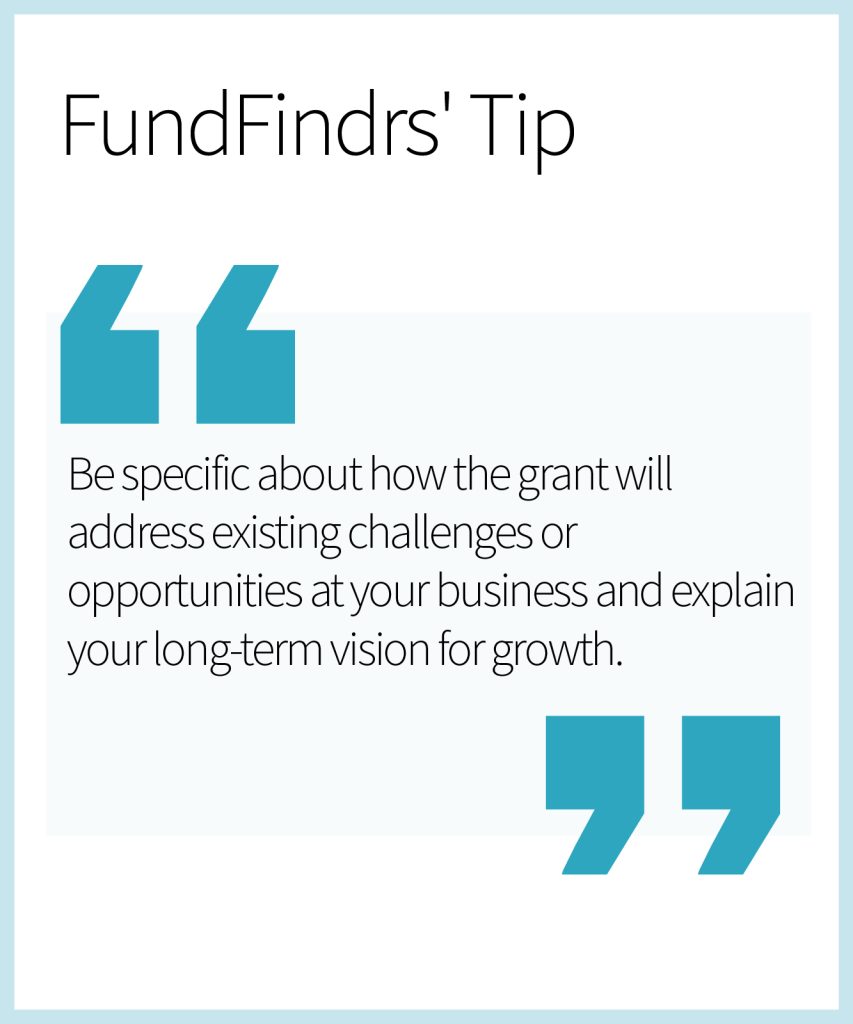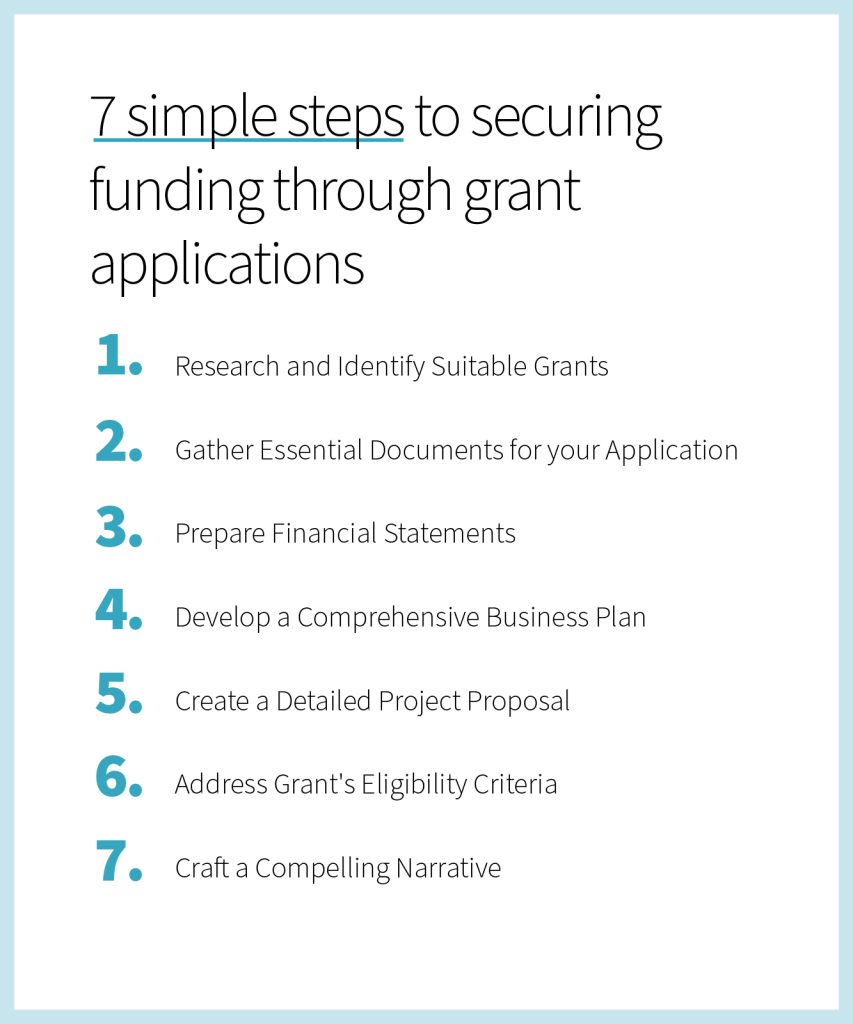Seven Simple Steps to Securing Funding Through Grant Applications.
Navigating the world of grant applications can be challenging, particularly for small and medium-sized businesses that may feel overshadowed by larger competitors. However, securing grant funding can be a vital strategy for growth and innovation especially for companies in industries such as biotech, pharmacy, food and beverage, technology and manufacturing.
Grants not only provide financial resources but also help companies invest in research, innovation, expand their market reach, and enhance their operational capabilities.
In this guide, we’ll outline seven simple steps for applying for grants effectively and explain how FundFindrs can support you throughout the process.
Why Grants matter
You might be asking yourself, “Why are grants so important for my business?”
Grants act as a vital financial resource for companies, allowing them to fund projects that propel growth and improve competitiveness. Unlike loans, grants don’t need to be repaid, making them an attractive option for investing in areas like research and development or exporting initiatives. For example, a grant could provide the necessary capital to develop innovative products or services that meet emerging market demands.
By recognising and utilising these funding opportunities, businesses can not only enhance their operational capabilities but also position themselves for greater success in an increasingly competitive landscape.
To help you tap into these opportunities, we’ve outlined a step-by-step approach to navigating the grant application process.
- Step 1 | Research and identify suitable grants
- Step 2 | Gather essential documents
- Step 3 | Prepare financial statements
- Step 4 | Develop a comprehensive business plan
- Step 5 | Create a detailed project proposal
- Step 6 | Address eligibility criteria
- Step 7 | Craft a compelling narrative
Step 1 | Research and identify suitable grants
You can start by identifying grants that align with your business objectives. It involves understanding both your specific needs and the available funding options.
Start by asking yourself:
- What are my business goals, and how can grant funding help achieve them?
- Which projects or initiatives do I want to fund?
- What eligibility criteria do I meet for potential grants?
- Am I able to follow all requirements and application deadlines?
Consider exploring the following sources to find relevant grants:
- Government websites: The Australian Government’s grants portal and your state or territory’s business funding resources are great starting points.
- Industry associations: Many industry-specific associations offer information on grants tailored to your sector.
- GrantFindrs Portal: If you are a FundFindrs member, you have access to Australia’s largest grants database, with 9,000 sources of grants that are updated daily. Just ask your Account Manager for information on how to access it.
There are numerous grants available, and you can use these resources to create a tailored shortlist that aligns best with your business objectives.
Step 2 | Gather essential documents
Preparing the necessary documentation is a critical part of the grant application process.
Commonly required documents include:
- Business registration details
- Financial statements: including profit and loss statements, balance sheets, and cash flow statements.
- Tax returns
- Proof of eligibility: such as industry certifications or licenses.
Ensure that your documents are well-organised and clearly presented. Use headings, bullet points, and concise language to enhance readability. For easy access when completing your application, consider compiling these documents in a digital folder, create a process to review and update it always as needed.
Step 3 | Prepare financial statements
Your financial statements are a snapshot of your business’s health and should include:
- Profit and loss statements: Highlight revenues, expenses, and net income over a specified period.
- Cash flow statements: Provide insight into the cash coming in and going out of your business, which is crucial for assessing liquidity.
- Balance sheets: Show your business’ assets, liabilities, and equity at a specific point in time.
Consider consulting with a specialised team, such as the FundFindrs experts, to ensure these statements are accurate and presented professionally. Well-prepared financial statements not only establish credibility but also demonstrate your business’s viability to grant reviewers.
Step 4 | Develop a comprehensive business plan
A robust business plan is essential for grant applications. Your plan should include:
- Executive summary: A concise overview of your business and its objectives.
- Business description: An outline of your industry, target market, and competitive landscape.
- Goals and objectives: Clear, measurable objectives that the grant funding will help you achieve.
- Project description: Detailed information about the project for which you’re seeking funding, including its relevance and expected outcomes.

Step 5 | Create a detailed project proposal
A project proposal for grants application should cover the following key elements:
- Project objectives: Clearly define what you aim to achieve.
- Methodology and approach: Outline the steps you’ll take to implement the project, including timelines.
- Budget breakdown: Provide a detailed account of how grant funds will be allocated, including direct costs and indirect expenses.
- Timeline and milestones: Set clear deadlines for each phase of the project and describe how you will measure success.
This structured approach demonstrates your project’s feasibility and aligns with the expectations of grant reviewers.
Step 6 | Address eligibility criteria
Each grant has specific eligibility criteria that must be met. Familiarise yourself with these requirements to avoid disqualification.
For example:
- R&D Tax Incentive (R&DTI): Eligible entities must be incorporated in Australia, meeting the spending threshold and conduct eligible R&D activities.
- MVP Ventures: This grant targets NSW startups seeking to commercialise innovative products, requiring a clear path to market and potential for growth.
By ensuring your business meets the required criteria, you enhance your application’s chances of success.
Step 7 | Craft a compelling narrative
When writing your grant application, tell a compelling story that engages the reviewers. Consider the following questions to guide your narrative:
- What inspired the idea for this project?
- How will this funding impact your business and community?
- What are the potential outcomes and benefits of the project?
- Why is your business uniquely positioned to achieve these objectives?
A strong narrative not only outlines your project’s merits but also highlights your business’s vision and commitment to making a positive impact.

How FundFindrs can help your business
At FundFindrs, we specialise in simplifying the grant application process for businesses.
Our experienced consultants guide you through each step, from identifying suitable grants to crafting compelling proposals. We help you streamline documentation, ensure compliance with eligibility criteria, offering valuable insights, guidance, and expertise to enhance your chances of success.
Are you ready to navigate the grant landscape with confidence and secure the funding needed to fuel your growth? Book a FREE consultation with our experts.




